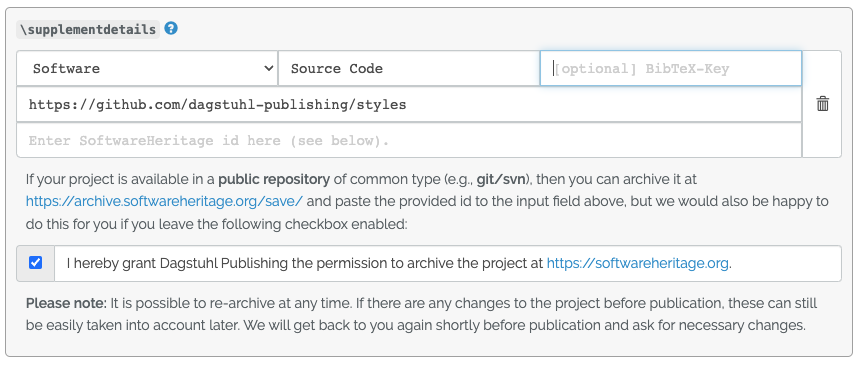To ensure the reproducibility of research results, it is important that all components used in a research project (e.g. software or data) are made accessible and referenced in the resulting publication. The new submission workflow, introduced in April 2023, is designed to facilitate this kind of linkage for our authors.
At LaTeX level, Dagstuhl Publishing has supported this for some time: All Dagstuhl LaTeX styles provide the macro \supplementdetails for this purpose. To give a concrete example,
\supplementdetails[subcategory={Source Code}]{Software}{https://github.com/dagstuhl-publishing/styles}
would properly list the project https://github.com/dagstuhl-publishing/styles as supplementary material on the title page and in the metadata of the paper.
Recently, we also offer the possibility to provide this information conveniently in our user interface during upload:

In a dedicated submission step, we request the relevant information via a form. (Macros already set in the LaTeX file are automatically taken into account).

As shown in the example, Dagstuhl Publishing is happy to take care of the archiving of our software projects at SoftwareHeritage for the authors. All an author has to do is to give us permission for archiving in advance via a checkbox.
We use controlled vocabulary from our DOI provider DataCite to classify Supplementary Materials. Possible classifications are: Audiovisual, Collection, DataPaper, Dataset, Event, Image, InteractiveResource, Model, PhysicalObject, Service, Software, Sound, Text, Workflow, Other. In addition, a subcategory can be set in the form of free text (in the example: subcategory={Source Code}).
Our editorial staff then takes care of the typesetting and integration into the LaTeX document. Of course, we ask the authors for approval before publishing the final version.
In the end, the Supplementary Materials will appear on the title page of the PDF as well as on the metadata page in our new publication server DROPS (see the figure below), as well as in the metadata exports for DataCite and in our XML export (used, e.g., by dblp).

The components for the new submission workflow and software archiving were developed as part of the FAIRCORE4EOSC project. For more information, please see our FAIRCORE4EOSC project page.
The next steps are to collect and publish metadata (such as developer, title, licence, etc.) of the associated software projects. In addition, guidelines will be provided for the authors on how to correctly cite the software as well as artefacts of this software with these descriptions.


